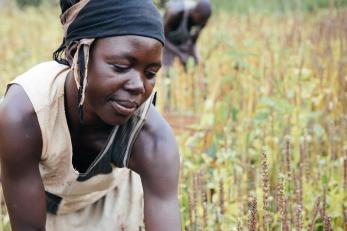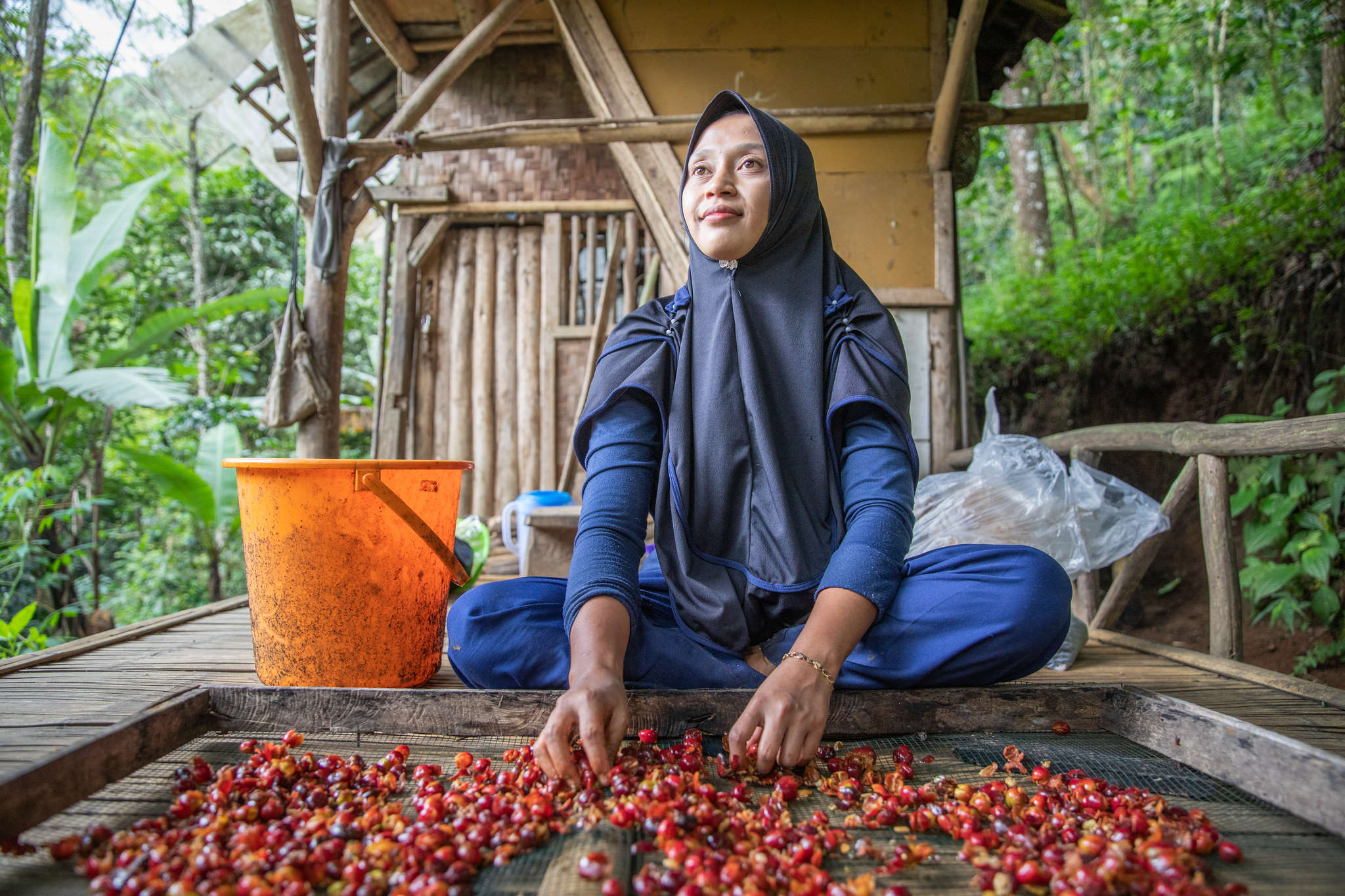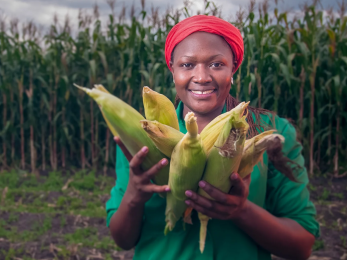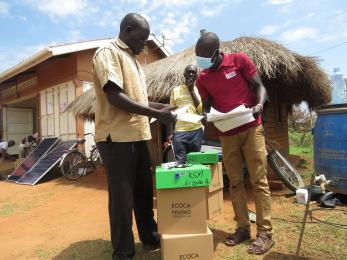A couple finds their future in chia

Charles and Concy have never heard of “superfoods.” They’re not sure what people do with these unusual seeds they are harvesting, but the couple believes they might be the key to a more prosperous future for their family.
Together, Charles and Concy took a risk — they planted one acre of chia on their farm this year. With help from Mercy Corps, they are learning how to successfully grow the new crop — and how to work their farm as equal partners.
When I visit the couple’s homestead, I am taken by its verdant landscape and lush beauty. Two grass-roofed huts stand in a clearing in the centre, with a few papaya trees and some sorghum towering in a field at the entrance. Chickens peck busily around the dirt yard.
Neighbours begin to arrive, hoping to get a first glimpse of the new crop Charles and Concy took a chance on.
Concy cleans the chia seeds while Charles shares a first taste with some of the gathered neighbours. The women laugh nervously at the strange new taste and texture, but say they want to grow chia in the upcoming season, too.
The neighbours pass around their chubby-cheeked baby while the couple continues to work. He’s the youngest of the couple’s five children. “I want to educate the children well, so that’s why I’m working so hard,” said Charles.
It’s a tidy home that, if not exactly prosperous, is peaceful. Watching the scene now, it’s easy to forget that this part of the country was gripped by a brutal civil war not long ago.
Charles and Concy were among the 2 million Ugandans displaced by the conflict, living in camps and depending on Mercy Corps and other organisations just to survive.
Twenty years of civil war took a huge toll, and an entire generation was disconnected from traditional farming practices. 80 per cent of Uganda’s workforce relies on agriculture to make a living.
“During the war, people lost their land,” said Kalokwera Mathew, a Mercy Corps staff member. “And they also lost their production techniques or system, the cultural techniques they have been using. They also lost their seeds, the seed foundation that they had.”
When a peace agreement was solidified in 2007, people started to return to their homes — and Mercy Corps began looking for ways to help Ugandans build new, and improved, lives in the region.
People like Charles and Concy finally had stability and their own plots of land. Mercy Corps knew that revitalizing the local economy would be key, and farming was a natural place to start.
Charles and Concy are just two of 370 farmers participating in a Mercy Corps pilot programme to introduce chia to their region of Uganda. But it took some convincing — chia, rich in nutrients and popular in western health food stores, has never been grown here before.
“At first we were afraid to grow chia,” said Concy. “We were nervous because we didn’t know how to grow it, what we needed to do in the garden.”
The program was modeled after a successful effort to bring sesame to the region. A local partner, an exporter called SAGE Uganda, trains farmers to grow and harvest high-quality chia that will be valuable on the international market.
After getting the knowledge they needed from the training sessions, the couple bravely planted their first round of chia.
This work is also encouraging women and men to work together and become equal partners in the farming process. Traditionally, women work in the fields, but men take the crop to market and handle any earnings.
To take part in the new chia programme, Mercy Corps and SAGE Uganda require both the husband and wife to sign all contracts and to attend any trainings together.
“Women have really gotten a sense of ownership,” said Mathew. “They are getting exposed now to the real market world and getting to understand it. If it continues like that, I really think that we are going to achieve something great.”
Engaging both men and women in all aspects of the business brings families together and gives couples like Charles and Concy a true feeling of partnership.
Just three months after planting the chia, they are already setting an example of great teamwork — they work side by side, chatting happily in the fields as they spend hours harvesting their new seeds.
Charles and Concy’s field of chia is nearly thigh-high at harvest time, and they use hand tools to carefully cut the dried flower off each stalk. The intense heat of the dry season hasn’t yet set in here, but it’s still hot, hard work.
Even so, they told me that growing chia is a relief from the backbreaking labor required for what they used to grow here: cotton. Cotton prices have fallen steeply in recent years, making the difficult labour less and less sustainable.
The couple already has a contract to sell their chia seeds for nearly five times the current price of cotton. “The crop has a very high value compared to any other crop I’ve grown,” Charles said.
So far this season, unseasonable rains during harvest time have been the biggest threat to Charles and Concy’s investment. As anyone who’s ever added chia to a morning smoothie knows, the seed swells and releases a gel-like substance when it gets wet.
A few unwelcome sprinkles bring the afternoon’s harvest to a temporary halt. Charles was warned that moisture would ruin his crop, so he quickly rolls up a new tarp full of drying chia and pulls it into a grass-roofed hut.
Once the rain passes, Charles and Concy return to their threshing. They stuff the chia stalks into large bags and beat them with specially-carved bats to separate the seed from the chaff. Despite the tough work, the two clearly enjoy each other’s company.
“People are so curious about it,” said Charles. “The biggest problem here has been Striga weed, but when my neighbours came and saw this garden, you can’t even see any Striga weed. That means the chia has killed the weed. So all the people around this place, they want to grow chia now.”
“The change in this community is that the farmers are more curious,” Charles said. “They always come to get information from me, and they are starting to think of farming as a source of income. Before, we only used to grow crops for food, not thinking about cash.”
Working together as a team, the young couple has a newfound confidence in what they can achieve. Ten years ago, living in a displacement camp and surrounded by violence, it was impossible for Charles and Concy to dream of a better future.
Now, they want to make plans. They’ll pay school fees for their children with the profits from the chia crop. They also hope to invest in a pair of oxen, which would allow them to farm more chia.
“I want to build a permanent house on this land,” said Charles. In the long-run, Charles and Concy want to start a new business in town. What it will look like, they’re not sure, but they are confident that they can make it happen.
For so long life here was tenuous, and the idea of a stable home and a prosperous family seemed like a distant dream. But Charles and Concy remind me that when people work together, remarkable recovery is possible.
“I am so hopeful for the future,” Charles said. Concy smiles and agrees. The couple’s big dreams rest on the potential of a tiny seed, and after the first day of the harvest, their optimism seems well-placed.
With the promise that chia holds for people like Charles and Concy, it does indeed seem to be a superfood.


